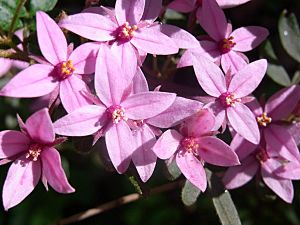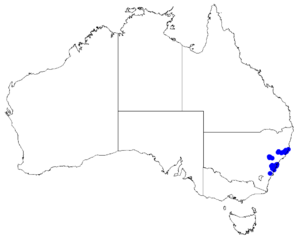Soft boronia facts for kids
Quick facts for kids Soft boronia |
|
|---|---|
 |
|
| Scientific classification | |
 |
|
| Occurrence data from Australasian Virtual Herbarium |
The Boronia mollis, also known as soft boronia, is a special plant. It belongs to the citrus family. This plant is found only in New South Wales, Australia. It grows as a shrub with leaves that look like feathers. You can spot its small groups of pink flowers growing where the leaves meet the stem. Soft boronia likes to grow in forests near the coast.
Contents
What Does Soft Boronia Look Like?
Soft boronia is a shrub that stands upright. It can grow up to about 2 meters (6.5 feet) tall. Its branches are covered with tiny, star-shaped hairs when they are young. As the branches get older, they become smooth.
Leaves and Scent
The leaves of the soft boronia usually have three to nine smaller leaflets. These leaves are about 10 to 60 millimeters (0.4 to 2.4 inches) long. The main stem of the leaf is 2 to 28 millimeters (0.08 to 1.1 inches) long. The leaflet at the very end is usually wider and longer than the side ones. The top of the leaves is smooth, and the bottom is paler with a few hairs. If you smell the leaves, they have a unique scent, a bit like citrus mixed with tar.
Flowers and Petals
Soft boronia flowers grow in small groups of two to six, usually three. They appear where the leaves join the stem. Each flower sits on a small stalk about 6 to 20 millimeters (0.2 to 0.8 inches) long. The flowers have four sepals, which are like small leaves protecting the bud. These sepals are 3 to 5 millimeters (0.1 to 0.2 inches) long. They grow bigger as the fruit develops and have hairs on their back.
The four petals are pale to deep pink. They are usually 7 to 10 millimeters (0.3 to 0.4 inches) long. The petals also grow a little bigger as the fruit forms and have hairs on their back. Unlike some flowers, the bases of these petals do not overlap. Each flower has eight stamens, which are the parts that produce pollen. The stamens closest to the sepals are longer. The pollen-producing parts, called anthers, are yellow. Soft boronia flowers bloom from June to November.
Naming This Plant
The plant Boronia mollis was first officially described by John Lindley. He used notes from Allan Cunningham. This description was published in a book called Edwards's Botanical Register. The very first plant used for this description was found near the Nepean River in 1825.
The second part of its scientific name, mollis, is a Latin word. It means "soft." This name refers to how soft the leaves feel and the hairs on the plant's stem.
Where Does Soft Boronia Live?
Soft boronia is a rare plant. It grows in dry eucalypt forests. You can find it in areas from the Kendall district all the way to the Wollemi and Blue Mountains National Parks.
Growing Soft Boronia at Home
This type of boronia is one of the tougher ones, making it a popular choice for gardeners. If you want to grow it, it needs soil that stays moist but drains well. It also prefers a spot with some shade, not full sun.

